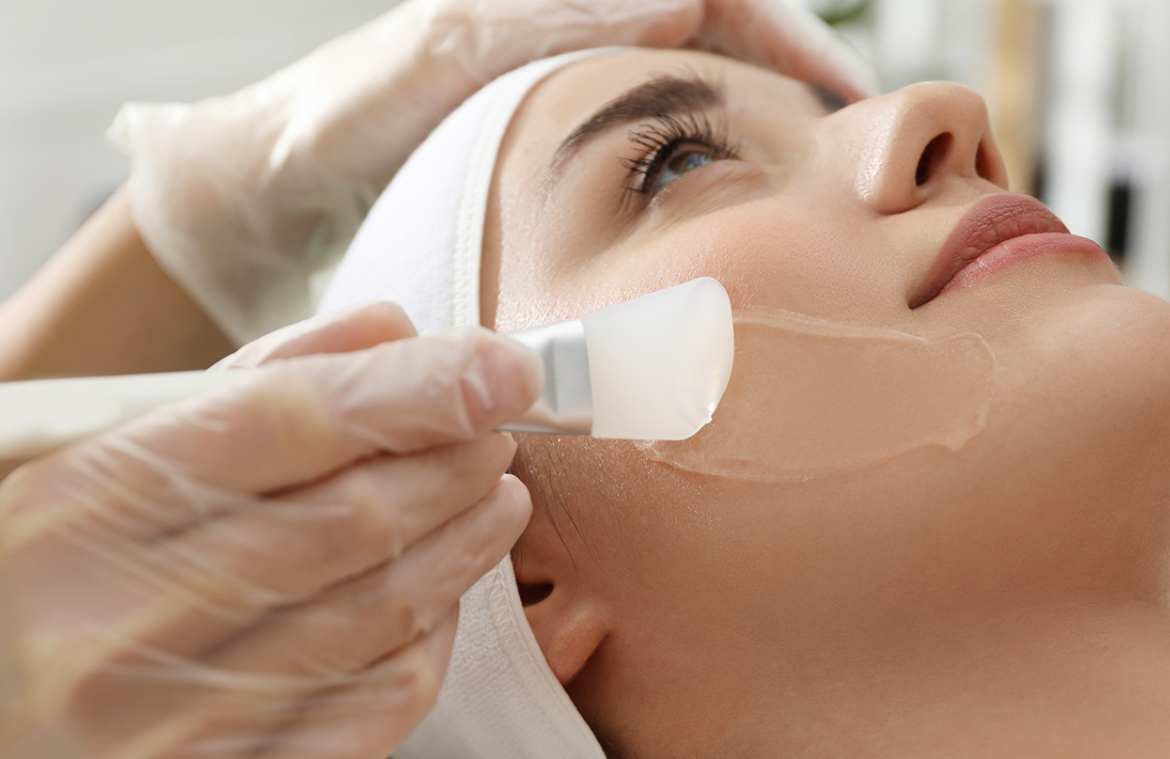
Chemical peels are cosmetic treatments used to improve the appearance and texture of the skin. They involve the application of a chemical solution to the skin, which causes it to exfoliate and eventually peel off, revealing fresher, more youthful skin underneath. Here’s an in-depth look at chemical peels, including types, benefits, procedures, and aftercare:
Lorem ipsum dolor sit amet, consetetur sadipscing elitr, sed diam nonumy eirmod tempor invidunt ut labore et dolore magna aliquyam erat, sed diam voluptua. At vero eos et accusam et justo duo dolores et ea rebum. Stet clita kasd gubergren, no sea takimata sanctus est Lorem ipsum dolor sit amet. Lorem

. Types of Chemical Peels
Superficial Peels:
- Description: These peels penetrate only the outermost layer of the skin (epidermis).
- Common Acids Used: Alpha hydroxy acids (AHAs) like glycolic acid or lactic acid.
- Benefits: Improves skin texture, reduces mild discoloration, and promotes a radiant complexion.
- Downtime: Minimal, with little to no peeling.
. Benefits of Chemical Peels
- Improves Skin Texture: Enhances the smoothness and texture of the skin by removing damaged outer layers.
- Reduces Wrinkles: Can minimize the appearance of fine lines and wrinkles.
- Evens Skin Tone: Helps in reducing pigmentation issues such as age spots, melasma, and post-inflammatory hyperpigmentation.
- Treats Acne: Unclogs pores and reduces acne breakouts by removing dead skin cells and promoting cell turnover.
- Enhances Radiance: Promotes a brighter and more youthful appearance by revealing new skin.
3. The Chemical Peel Procedure
Consultation:
- Assessment: A thorough evaluation of your skin type, concerns, and medical history is conducted.
- Treatment Plan: Your provider will recommend the type of peel best suited to your needs and discuss potential risks and benefits.
Preparation:
- Cleansing: The skin is cleansed to remove makeup, oils, and impurities.
- Pre-Treatment: Some peels may require pre-treatment with a preparatory solution or a series of preparatory treatments.
Application:
- Chemical Solution: The chosen chemical solution is applied to the skin. The type and strength of the solution will determine the depth of the peel.
- Duration: The solution is left on for a specific amount of time, depending on the type of peel. This may range from a few minutes to 20 minutes or more.
Neutralization and Removal:
- Neutralization: For certain types of peels, a neutralizing solution is applied to stop the chemical reaction.
- Removal: The chemical solution is then removed, and the skin is treated with soothing products.
4. Aftercare and Recovery
Post-Treatment Care:
- Moisturize: Use gentle, hydrating moisturizers to keep the skin hydrated.
- Sun Protection: Apply broad-spectrum sunscreen daily to protect the new skin and prevent further damage.
- Avoid Irritants: Refrain from using harsh skincare products, exfoliants, or retinoids until your skin has fully healed.
Downtime:
- Superficial Peels: Minimal downtime, with possible redness and flaking.
- Medium Peels: Moderate downtime with redness, peeling, and sensitivity lasting up to a week.
- Deep Peels: Extended downtime with significant peeling, redness, and possible swelling for several weeks.
Healing:
- Superficial Peels: Healing is usually quick, with minor flaking.
- Medium Peels: New skin begins to form within a week, with peeling occurring over several days.
- Deep Peels: Healing can take several weeks, with gradual improvement in skin texture and appearance.
5. Risks and Considerations
Potential Side Effects:
- Redness and Swelling: Common in medium and deep peels.
- Hyperpigmentation: Dark spots may develop, particularly in individuals with darker skin tones.
- Infection: Though rare, infections can occur if proper aftercare is not followed.
Pre-Existing Conditions: Inform your provider of any skin conditions, such as eczema or psoriasis, which may affect the treatment.
Sun Exposure: Avoid excessive sun exposure during the recovery period to prevent complications and hyperpigmentation.
6. Ideal Candidates
- Skin Concerns: Those with issues such as fine lines, uneven skin tone, acne scars, or sun damage.
- Health Status: Generally healthy individuals who can tolerate the procedure and follow post-care instructions.
7. Finding a Qualified Provider
- Experience and Credentials: Choose a licensed dermatologist, plastic surgeon, or aesthetician with experience in performing chemical peels.
- Consultation: Discuss your goals, expectations, and any concerns during the initial consultation.
Chemical peels can be a highly effective way to rejuvenate the skin and address a variety of skin concerns. Understanding the types, benefits, and aftercare involved can help you make informed decisions and achieve the best results from your treatment.
dunt ut labore et dolore magna aliquyam erat, sed diam voluptua. At vero eos et accusam et justo duo dolores et ea rebum. Stet clita kasd gubergren, no sea takimata sanctus est Lorem ipsum
